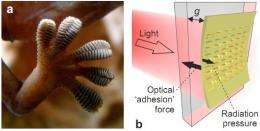January 27, 2012 report
British team builds model showing metamaterials could be used to create gecko toe like adhesion

Bob Yirka
news contributor

(Â鶹ÒùÔºOrg.com) -- Scientists have long been enamored by the gecko’s gravity defying ability to cling to walls and to let go at will, allowing it to walk around sideways, as have Spiderman enthusiasts. Thus far, unfortunately, efforts to duplicate such feats have gone unmet. Now however, researchers from the University of Southampton in England have built a computer simulation that shows that it might be possible to duplicate the gecko’s abilities by using special metamaterials and ordinary light. They have published the results of their studies on the preprint server arXiv.
The whole idea is based on the fact that light exerts a force on materials that it strikes. The research team used this force to create plasmons (oscillations of electrons) on the surface of a metamaterial - in this case, a substance made of mostly gold with optical properties that can control the way light behaves. They found that when light was shined through the metamaterial onto the interface between a metamaterial and the surface of another metal material an attractive force was created due to the oscillating electrons on the metamaterial interacting with the electrons on the second material. This result was not unexpected, the amount of force found however, was. They found that by adjusting the light source to a frequency close to the wavelength of the oscillating electrons on the surface of the metamaterial, they could produce an attractive force greater than the pull of gravity on the two materials.
The model the team has built demonstrates that it should theoretically be possible to create materials that are able to stick to and release from one another by simply turning a light source on and off, at least at the quantum level. If applied research finds the model holds, new metamaterials might be made that could be used for such applications as moving nano-sized objects around with tools equipped with a light source and metamaterials.
There is one still one more step in this new research, of course, and that is actually finding the force in a real life experiment and measuring it. The team said this shouldn’t be difficult and expect that it will be found within the next couple of weeks or months.
Written for you by our author —this article is the result of careful human work. We rely on readers like you to keep independent science journalism alive. If this reporting matters to you, please consider a (especially monthly). You'll get an ad-free account as a thank-you.
More information: Metamaterial 'Gecko Toe': Optically-Controlled Adhesion to Any Surface, arXiv:1201.2801v1 [physics.optics]
Abstract
On the mesoscopic scale, electromagnetic forces are of fundamental importance to an enormously diverse range of systems, from optical tweezers to the adhesion of gecko toes. Here we show that a strong light-driven force may be generated when a plasmonic metamaterial is illuminated in close proximity to a dielectric or metal surface. This near-field force can exceed radiation pressure and Casimir forces to provide an optically controlled adhesion mechanism mimicking the gecko toe: at illumination intensities of just a few tens of nW/um^2 it is sufficient to overcome the Earth's gravitational pull.
© 2011 Â鶹ÒùÔºOrg.com


















